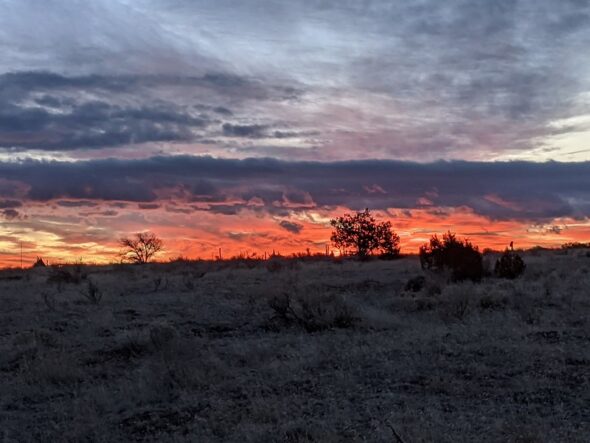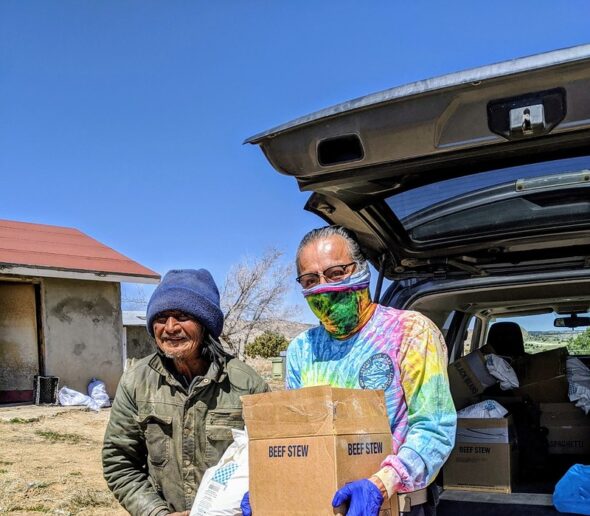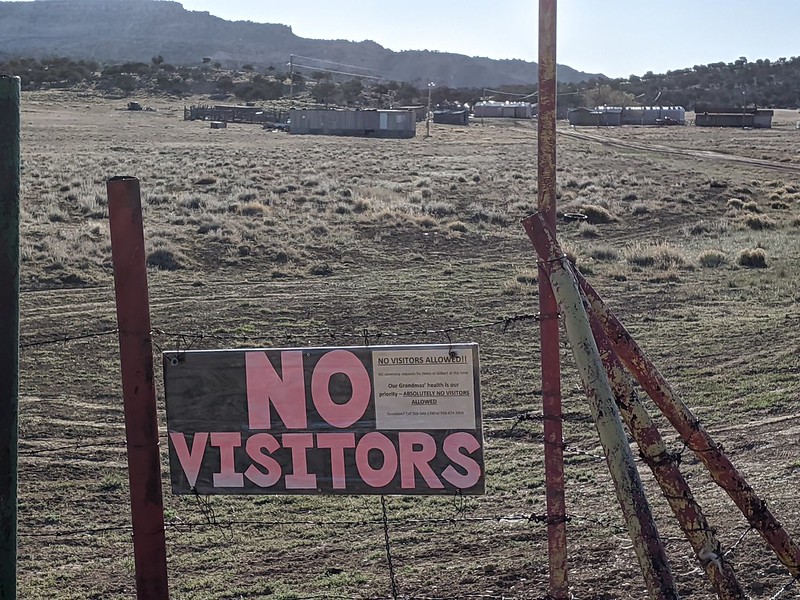The red letters on the wooden board gave a clear message: “NO VISITORS.” A paper attached to the sign hanging on a wire fence surrounding the rural home in the town of Blue Gap, Arizona, on the Navajo Nation made it even clearer: “Our grandma’s health is our priority- ABSOLUTELY NO VISITORS ALLOWED.”
Earl Tulley, 63, spotted the sign in the community where he was born as the coronavirus rips through the largest reservation in the United States. In rural communities, he said, locals and relatives tend to look out for one another and check in on their neighbors. Now, with the coronavirus pandemic, residents still share resources, like food, and reach out to each other but from a distance.
“In case of emergency, I can shine my mirror against the sun to my neighbors across the valley,” said Tulley, an environmentalist and executive office veteran liaison for the Navajo Housing Authority. “They know to come over.”
The Navajo Nation covers over 27,000 square miles, sprawling across Arizona, Utah and New Mexico. Home to about 175,000 people, the Indian country has reported 2,654 Covid-19 cases and 85 deaths as of Thursday. It has the third-highest infection rate in the United States behind New York and New Jersey, and a per capita infection rate 10 times higher than Arizona.

The Navajo Nation has reported reported 2,654 Covid-19 cases and 85 deaths as of Thursday. It has the third-highest infection rate in the United States behind New York and New Jersey. Photo of a sunrise courtesy of Earl Tulley
Before the pandemic, however, the Navajo, or Diné, people faced another kind of crisis: limited health care facilities, a prevalence of conditions like heart diseases and diabetes, few grocery stores and scarcity of running water. Now, these factors further complicate the Covid-19, or Dikos Ntsaaígíí-19, emergency in the community.
“Do you wash your hands or do you quench your thirst?” Tulley said. “That is something that a number of families are faced with right now.”
An estimated 30 percent of the community’s population does not have access to clean, reliable drinking water, and has to haul it from watering points due to severe infrastructure deficiencies, according to the Navajo Nation Department of Water Resources.
“Water comes at a premium,” Tulley said. “If you count the payment of the wear and tear on the vehicle and the payment of utilizing water, it’s calculated somewhere in the neighborhood of about $40 a gallon, because you’re your own utility provider.”
Under strict curfews, lockdowns and checkpoints to curb the spread of the coronavirus, a trip to haul water can be a struggle. The city of Gallup, in New Mexico, is a regional watering hole, and the trek to the community has been a practice of local tribes for generations. On the first day of the month, Tulley said, people tend to visit the city to socialize and haul water. This May 1, however, Gallup was placed under lockdown.
New Mexico Gov. Michelle Lujan Grisham on Friday invoked the state’s Riot Control Act to close off all roads leading to Gallup, in McKinley County, “to mitigate the uninhibited spread of COVID-19 in that city.” McKinley County accounts for nearly 30 percent of coronavirus cases in the state. The lockdown, requested by the city’s mayor, is scheduled to end today.
“I believe that those individuals that live closer to the watering hole basically depended too much upon it,” said Tulley. “I don’t think that they could phathom or even comprehend that Gallup would ever do this. But, with the pandemic that is happening now, some of the people are saying, ‘You know what, it’s about time.’”
On top of lack of running water, there is also the issue of quality. Water in communities like east To’hajiilee, in New Mexico, have high sulfur content, Tulley said. “There’s nothing wrong with it as far as health wise, but the stench and the smell of sulfur water is really, really bad,” he said. “It does wear and tear on your plumbing, and if you have a porcelain sink or a ceramic sink, then you can see the yellow marks.”
Difficulties to drive to haul water apply to the struggle to buy supplies during the pandemic, too. Roughly the size of West Virginia, the Navajo Nation has only 13 grocery stores, so residents drive hundreds of miles to border towns for groceries.
“Not very many people have transportations, and so those individual families who are not blessed to have a vehicle, then they would have to hitchhike,” said Tulley. “It’s not going to the corner market.”

Environmentalist Earl Tulley delivers a box of food to Dennis Charley in Tachee, Arizona. Photo courtesy of Earl Tulley
Recently, Tulley participated in a community effort to distribute 80,000 pounds of food on the reservation. The food distributed came from humanitarian aid collected in Salt Lake City, Utah, and went to several communities in the territory, from Farmington to Crown Point.
Rural families like Tulley’s have adapted to living within their means, herding sheep and depending on live stock. “If you’re able to go out into Mother Nature’s garden,” he said, “then you pretty much have a greater understanding as to how to live off the land.”
Like grocery stores, health facilities are limited on the reservation. There are 12 healthcare centers in the Navajo Nation and nearby areas, according to the Indian Health Service. In March, the tribe reported that it had 170 hospital beds, 13 intensive care unit beds, 52 isolation rooms and 28 ventilators.
“If you are working and you have insurance, the possibility of having your own specialists, your own doctor, that would be a blessing,” Tulley said. “But in many of our Navajo communities, people are dependent, and the only resource that they have, as far as Western medicine or medical care, is going to be through the public health service or the Indian Health Service.”
Navajo Nation President Jonathan Nez said that federal aid began to trickle into the Indian country in April and that the Indian Health Service facilities received vital equipment. Last month, the community distributed rapid test kits, protective equipment and 50 ventilators.
Nez said the community has not received the emergency funds needed for testing and equipment. The Navajo Nation is set to receive $600 million in federal funding from the distribution of the Coronavirus Aid, Relief and Economic Security (CARES) Act.
As the coronavirus tears through his tribe, Tulley has taken the time to share with his four grandchildren and teach them to garden. He tells them that, if they plant a seed in the ground, they must nurture and sing to it so it can grow.
He reassures them that life will come back to normal at some point.
